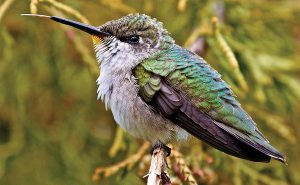
My barely-a-toddler granddaughter is fascinated by everything. To her, dirt has wonderful textures and indeed may be edible. Touching soft leaves or prickly conifer needles brings a smile to her face. The birds that hang out in neighborhood gardens are endlessly entertaining. Chain link fences are like mountains that must be climbed because they can be climbed. Yet there are many other wonders of this world that are not so obvious and that in some cases take keen observation, a little math and some specialized equipment to discover. So embrace your inner nature nerd, learn some new words to impress your Scrabble-playing friends and be amazed by some of the things people have learned about the incredible living things in your Metro Parks.
Hummingbird’s tongue…
The ruby-throated hummingbirds we see from late spring to early autumn are a small part of an estimated population of 7 million birds. At an average weight of 1/8 ounce each, the entire population weights about 55,000 pounds. To put this into perspective, one male adult blue whale weighs close to 300,000 pounds.
Conventional wisdom was that hummingbird tongues were like side by side straws using capillary action- liquid rising against gravity through a tube – to drink nectar. With the extraordinary energy requirements of hummingbirds this idea didn’t make sense to scientists. Using a high speed camera and artificial see-through flowers, researchers at the University of Connecticut discovered that hummingbirds have a tubed, forked tongue that opens along its sides. When bringing the tongue back into the beak, the tips of the tongue come together, and the sides zip closed trapping nectar within. The next challenge is to determine how hummingbirds can swallow as many as 20 times per second.
Life underground…
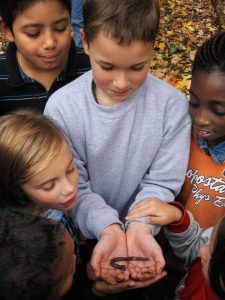
We rarely consider that most life is unseen by humans. Two-thirds of the earth’s biodiversity lives in terrestrial soils and underwater sediments. An acre of healthy topsoil contains an average of 130 pounds of algae, 880 pounds of earthworms, 880 pounds of insects and their relatives, 1500 pounds of bacteria, and 2400 pounds of fungi. A single square yard of soil might contain as many as 10 million microscopic roundworms called nematodes. A shovel full of rich garden soil may have more species than the entire Amazon River basin has above ground.
Earthworms feed by swallowing everything in their path that is small enough to consume. Only food is digested – everything else passes through as castings. They have no eyes but use light receptors to tell if they are in the dark or light. Earthworms have five heart-like organs called aortic arches that move blood through their bodies. The worms we see in Central Ohio are usually European natives. Earthworms are tough but they couldn’t survive the last glaciers so few native worms are found in most of Ohio. While we hear that earthworms are good for the soil, that’s not always true. In Central Ohio’s heavy clay soils, root growth is helped when worms aerate and loosen the soil. In lighter soils, their castings can compact the soil making it harder for seeds to germinate and grow. And in hardwood forests, earthworms often cause leaf litter to decompose too quickly and nutrients to become less available to plants and animals.
Salamander reproduction…
Unisexual, entirely female populations of Ambystomatid or mole salamanders live throughout the Great Lakes area and probably occur at Glacier Ridge Metro Park. These unisex salamanders can be a mix of two, three, four or even five species and have highly variable characteristics. More than 20 different genetic combinations have been found so far. All but one have genes from the blue-spotted salamander, so they usually have blue flecks along their sides. Like all mole salamanders, they migrate to vernal pools in late winter and early spring. After mating with a male of a related species, females usually discard that male’s genes and eggs develop as clones of the female. Occasionally the male’s genes replace existing ones or increase the number of chromosomes in the offspring. This kind of reproduction is called kleptogenesis and results in all-female or rarely, sterile male young.
Opossums are beneficial…
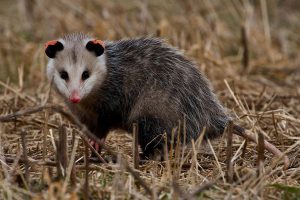
Let’s be honest, some creatures are beautiful only in the eyes of their beholder. They look odd, smell bad, occasionally do things people find distasteful and are still wonderful in their own ways. Looking a bit like an animal thrown together with parts from an abandoned junk drawer, the opossum is not renowned for its intelligence. But researchers at the University of Georgia discovered that opossums remembered where food was located in complex mazes better than dogs, cats and rabbits. Only humans were clearly superior to opossums. Cornell University scientists learned that opossums quickly learn to tell the difference between similar appearing edible and poisonous mushrooms. That’s not all – over millions of years, opossums evolved resistance to rattlesnake and copperhead snake venom, showing few if any negative effects from snake bites. They groom themselves very efficiently, eating 95 percent of the ticks that crawl onto their bodies.
Skunk’s spray…
From a distance, skunk spray is strong but not that unpleasant. Up close, it’s a different story. Our noses are extremely sensitive to sulfur thiols, the compounds in garlic, onions and skunk spray. Skunks can spray with their tail up, down or even curled under their body, but they prefer not to spray unless they have to since it can take several days to fully recharge after firing. They can spray a direct stream accurately to 10 feet or send the spray out in an all-encompassing mist. The oily, yellow spray is flammable and can’t be removed with tomato juice but can be removed with a solution of hydrogen peroxide and baking soda. Since they have almost no sense of smell, great-horned owls are the only regular predators of skunks.
Turkey vulture adaptations…
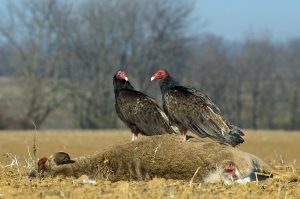
Turkey vultures are different from owls and other birds – they have a great sense of smell that lets them find the carcass of animals even beneath a forest canopy. They prefer to eat relatively fresh meat, choosing soft bits first while avoiding particularly rank things like skunk scent glands. Their featherless heads help them stay clean just as defecating on their legs cools them off on hot days. If they are disturbed or threatened both young and adult turkey vultures will projectile vomit on their enemies.
The little things that run the world…
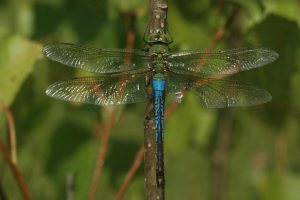
Insects of all kinds are part of what biologist E.O. Wilson calls “The Little Things That Run The World.” Bumble bees are not only great pollinators of tomatoes but build up a positive electrical charge as they flap their wings. Working like static cling, this helps pollen stick to their hairs. Electrical charges might help the bumble bees tell if a flower was just visited by another bee – if it was, it may not have much nectar or pollen available.
Some of our favorite spring wildflowers depend on ants for their continued survival. Bloodroot, trout lily, large-flowered trillium and Dutchman’s breeches are a few of the spring wildflowers whose seeds are covered with an oily, fatty coating called an elaiosome. Ants carry the seeds to their underground homes and feed the elaiosomes to their larvae. The cleaned seeds are moved to the ant equivalent of a compost pile where they can germinate and grow. It’s a win-win situation for the ants and the plants. Seed dispersal by ants even has its own name – myrmecochory.
Most of us are familiar with the annual monarch butterfly migration but few know about another spectacular insect migration. Common green darner dragonflies have residential and migratory populations. The residential green darners spend their lives in a small area while migratory ones fly to Florida and maybe even farther in the fall. They mate, lay eggs, and the larvae develop quickly in warm water. After becoming adults, these dragonflies migrate northward and the cycle continues. Tens of thousands of green darners are sometimes seen on these migratory flights.
Red fox…
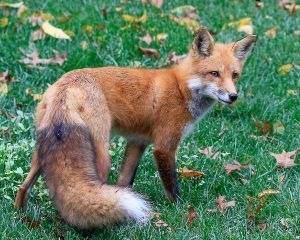
Red foxes eat a lot of mice. Even when snow covers the ground, they use their hearing to find their prey and catch them with a leaping pounce. Scientists in the Czech Republic observed that 73 percent of hunts were successful if the fox was jumping a northeast direction. Only 18 percent of hunts were successful in other directions. The scientists suggest hunting foxes use Earth’s magnetic field to find the perfect spot to pounce from.
Yellow-bellied cuckoo…
Most birds prefer that their caterpillar meals are smooth and free of prickly bristles. Not the yellow-billed cuckoo. More than 100 eastern tent caterpillars have been found in the stomachs of some cuckoos. Over time, the undigested bristly hairs from the caterpillars form a felt-like mat in the birds’ stomachs. When the mat interferes with digestion it is regurgitated and the cuckoo grows a new stomach lining. Yellow-billed cuckoos have one of the shortest nesting periods of any bird. It can be as few as 17 days from the time an egg is laid to when a young cuckoo flies on its own.
Busy beavers…
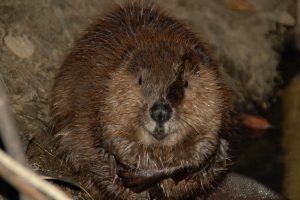
While we often see trails or gnawed tree stumps near wooded streams, we rarely see the beavers that make them. A few years ago a celebrity chef told a television audience that vanilla ice cream is flavored with extract obtained from a beaver’s rear end and an internet myth was born. Beavers mark their territories with castoreum from their castor glands. Even its scientific name, Castor canadensis, is derived from it. Castoreum contains hundreds of chemical compounds so several decades ago researchers removed some of these from castoreum and used them to make, among other things, raspberry flavoring and imitation vanilla extract. But it turns out that making products from castoreum is extremely expensive and less than 300 pounds of it are used worldwide each year in the food industry. Instead, millions of pounds of these flavorings are made from something much less glamorous – wood pulp and petroleum by-products.
In case you were wondering, researchers who regularly handle beavers say that they smell quite good. The same scientists who studied the hummingbird’s tongue plan to use a technique called x-ray microtomography to learn how it swallows so rapidly. My granddaughter just discovered that dirt really is edible. And let us know if you were able to use elaiosome or kleptogenesis to win a game of Scrabble!
(By Scott Felker, Three Creeks Hub Naturalist)
